#banded woolybear
Photo

Vine maple is a true maple that grows quite differently from Willamette Valley’s other native Acer, the bigleaf maple. True to its name, vine maple grows in a vine-like pattern, sending stems out horizontally, seeking out breaks in the overstory where the sun comes through. But only when growing in shade. When it grows in the sun, vine maple’s multiple stems grow vertically, forming a V-shaped silhouette. You have likely seen this large shrub in many Portland-Vancouver gardens, planted for its characteristic maple foliage, vibrant fall color, and elegant, silvery bark.
Vine maple offers multiple benefits to the various ecosystems it grows in. It re-establishes quickly after wildfires, creating shade for ground cover plants such as sword ferns. As well as needed cover and food for squirrels, chipmunks, black-tailed deer, elk, and mountain beavers. Numerous bird species rely on vine maples for food and nest-building material, including two species of water birds, nine species of upland birds, and six species of songbirds. Add to that the ten confirmed species (including the banded woolybear) and forty suspected species of butterflies and moths that use vine maples as a host plant. Altogether, you can see that vine maple facilitates essential habitat from the forested mountains down to the wetlands and grasslands of our valley.
You can grow vine maple in full shade to full sun and in moist to seasonally wet soils. Consider planting vine maple as a border to a pollinator meadow, in or around a rain garden, bordering a flood zone, or pretty much anywhere that gets enough moisture. Vine maples grow well with Douglas-firs, western hemlocks, Oregon ash, oceanspray, baldhip rose, and pacific waterleaf. As always, do not spray pesticides on or near your vine maple; doing so may harm or kill the shrub and the insects, birds, and mammals that rely on it.
For more like this go to portlandhabitatwatch.com
8 notes
·
View notes
Text
things i saw on my walk today - pt. 1
2 eastern ribbonsnakes
1 old barbecue
2 banded woolybear caterpillars
1 praying mantis
just enough milkweed
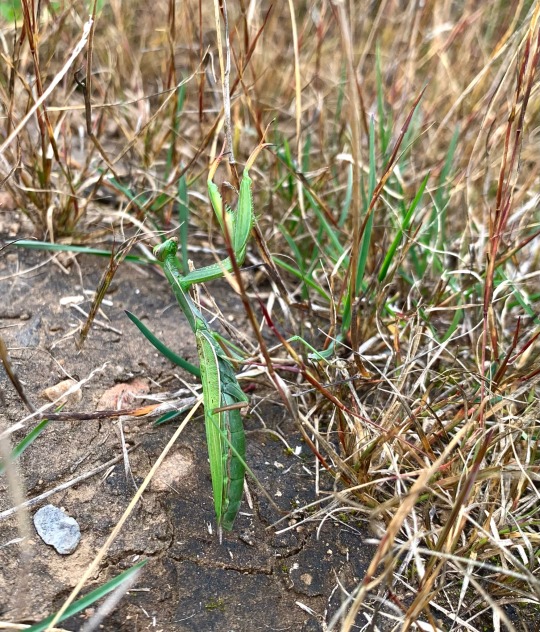
12/10/2022
#naturecore#nature#mosscore#walk#nature walk#praying mantis#snake#plant#observer#outdoors#caterpillar#milkweed#explorer
1 note
·
View note
Photo


fuzzy caterpillar
#mechandra draws#actual factual me#bugs#banded woolybear#no we did not handle it bare (bear lol)#we carried it safely on a piece of receipt paper#they really were not thinking about caterpillar migration patterns when they built this costco smdh
322 notes
·
View notes
Photo
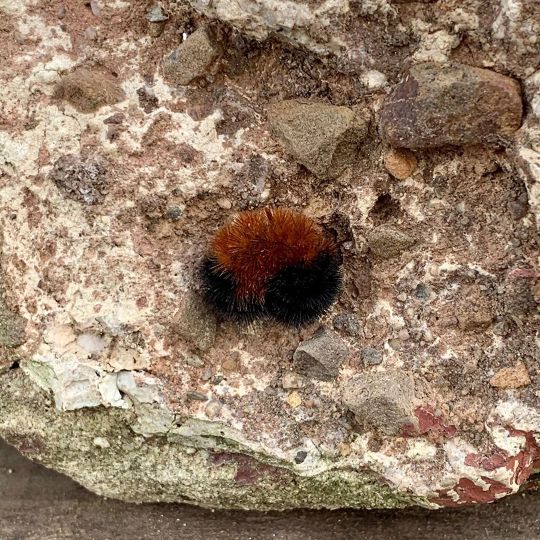
Under a rock, a wooly bear. A wide brown band is supposed to mean a mild winter. So far, it’s accurate here. #woolybear #winter #weatherlore (at Essex County, New Jersey) https://www.instagram.com/p/B8KiCdDBLxe/?igshid=13md2fih5yv6
0 notes
Text
Last year, I wrote a post on some wasps and bees I’ve found in my garden over the nine years I’d lived here. This is the second installment of the Garden Insects series, on butterflies & moths and their larvae. Future posts will cover flies, dragonflies, ants, beetles, grasshoppers, cicadas, and other bugs — some “true” bugs and some not. Possibly even worms and slugs, though they are not insects, or even in the same phylum as insects. Speaking of phylum …
_________________
SIDEBAR: The taxonomy of the insect world, briefly.
Insects are a CLASS in terms of taxonomy, within the PHYLUM called Arthropoda that’s part of the overarching KINGDOM Animalia, which contains about 2.2 million animal species, So yes, all insects are animals, though people often dispute this in casual conversation and social media.
Depending on how a phylum is determined (including whether only extant (non-extinct) animals are included or not), there are anywhere from 5 to 36 phyla in the animal kingdom; usually lists show 7 or 9 phyla, such as this one from a Yale University course that lists 9 phyla, the first 6 of which contain animals that live only in water or mud: Porifera (Sponges), Cnidaria (Jellyfish, Coral, Sea Anemones), Mollusca (Snails, Slugs, Octopus), Echinodermata (Starfish, Sand Dollar, Sea Cucumber, Sea Urchin), Annelida (Segment Worms, Leeches), Platyhelminthes (Flatworms), Nematoda (Nematodes, Roundworms, Earthworms), Chordata (everything with a backbone, so all Birds, Reptiles, Fishes, Amphibians and Mammals, including humans), and finally, Arthropoda (Insects, Spiders, Scorpions, Millipedes, Crustaceans).
This sortable list on Wikipedia, similar to a BBC Earth list, contains 35 phyla, but often many of these are considered a sub-phylum of a more encompassing phylum. Here’s a site that lists 21 phyla, while the Tree of Life project lists just 6: Porifera and Cnidaria, as above in the list of nine, but then none of the other seven, instead adding to and replacing them with Placozoa (extremely simple animals up to 3mm in size made up of only 4 cell types; only 2 species have ever been described), Ctenophora (comb-jellies), Myxoza (several-celled parasitic microscopic organisms) and the giant group of Bilateria, which includes all the vertebrates plus arthropods, molluscs, worms, and more!
Categorising life is complicated.
And don’t get me started on the top level of life Kingdoms (or Domains or Empires):
“In summary, today there are several competing top classifications of life:
The three-domain system of Carl Woese, with top-level groupings of Archaea, Eubacteria, and Eukaryota domains
The two-empire system, with top-level groupings of Prokaryota (or Monera) and Eukaryota empires
The five-kingdom system with top-level groupings of Monera, Protista, Fungi, Plantae, and Animalia
The six-kingdom system with top-level groupings of Archaebacteria, Monera, Protista, Fungi, Plantae, and Animalia
Overall, the majority of biologists accept the domain system, but a large minority uses the five-kingdom method.” (from New World Encyclopedia: Taxonomy)
So, leaving the weeds to recap for today’s posting on insects, insects comprise one CLASS (called Insecta) of the PHYLUM Arthropoda, which also contains, in other classes (not Insecta) such animals as arachnids (spiders, scorpions, ticks, mites, et al.), crustaceans, millipedes and centipedes, horseshoe crabs, and so on.
Within the CLASS Insecta are about 30 ORDERS, including our focus today, Lepidoptera (butterflies and moths), plus:
Hymenoptera: ants, bees, wasps, sawflies … it’s a big group
Hemiptera: all true bugs, within three sub-orders: Heteroptera – bugs; Auchenorrhyncha – cicadas, leafhoppers; and Sternorrhyncha – aphids, scales. True bugs are insects that have two pairs of wings and hypodermic-needle-like mouthparts, and they all undergo incomplete metamorphosis, with their young hatching from eggs to become nymphs, which are miniature versions of the adult bug minus the wings.
Diptera: flies — but not all insects with the word “fly” in their names; also mosquitoes
Coleoptera: beetles
Orthoptera: katydids, grasshoppers, crickets
Odonata: dragonflies & damselflies, each in its own sub-order
Trichoptera: caddisflies
Ephemeroptera “lasting a day”: mayflies
Mantodea “like a prophet”: mantises
Phasmatodea “like a ghost”: walking sticks
… and a couple dozen more. (Check out Bugguide’s intro or the list here.)
_________________ END OF SIDEBAR
*
Now on to the butterflies and moths, and their larva, i.e., caterpillars. (All photos from my yard this year unless noted otherwise.)
What’s interesting to me is that I commonly see both the larval and adult forms of some butterfly species, such as monarch butterflies and caterpillars (Danaus plexippus), while I typically see only either the larval or the adult form of others, such as black swallowtail butterflies (Papilio polyxenes); I’ve seen a handful of black swallowtail caterpillars in my yard this year and no adults, though I’ve seen a few flying around town. Same thing with yellow swallowtail butterflies, either Eastern tiger, Papilio glaucus or Canadian tiger, Papilio canadensis — I’m never sure which; I see lots of adults and no caterpillars, which are darned cute.
(Male) monarch butterfly, 12 Aug 2019; monarch caterpillar, 25 July 2019:
I like this monarch-in-flight photo that the motion camera caught on 2 Aug. 2019.

I’ve had two chrysalises hatch successful adult monarch butterflies in the garden, and I’ve seen at least three dozen monarch caterpillars on the milkweed plants (Asclepias syriaca and A. incarnata) since mid-July, including one large one today, which is getting to be too late for pupating, hatching, and flying to Mexico.
*
Black swallowtail butterfly, in the garden in Sept. 2015 ; black swallowtail caterpillar, 17 Sept 2019:
I’m still seeing black swallowtail caterpillars on dill in the garden now, too.
*
These are both Eastern yellow tiger swallowtails, both photographed on 25 July 2019; the one on the left is a female (more blue), the one on the right a male. I don’t have any photos of yellow tiger caterpillars, never having noticed one, but here’s one online — cute, right? Kind of like a spicebush caterpillar.
*
Similarly with MOTHS: I’ve seen loads of tussock moth caterpillars this year — it’s been a banner year for them in the northeast — but no adult tussock moths (they are beige and somewhat nondescript):

spotted tussock moth caterpillar (Lophocampa maculata) foreground, and looks like a banded tussock moth caterpillar (Halysidota tessellaris) in the background – 11 Sept 2019
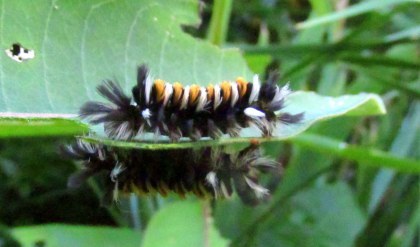
milkweed tussock moth caterpillar (Euchaetes egle), on milkweed – 25 Aug 2019

banded tussock moth caterpillar (Halysidota tessellaris) – 13 Aug 2019
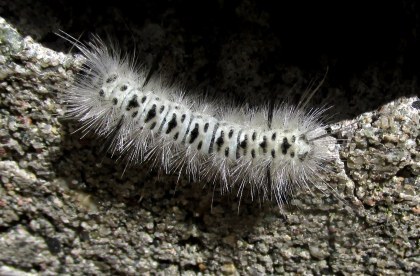
hickory tussock moth caterpillar (Lophocampa caryae) – 11 Aug 2019
*
I’m likewise seeing a fair number of woolybears, those fuzzy caterpillars of the banded woolybear moth aka Isabella tiger moth, Pyrrharctia isabella or of the yellow woolybear moth, aka Virginian tiger moth, Spilosoma virginica, but I’ve not noticed any actual moths of the species:

I think this is a Yellow Woolybear Moth caterpillar aka Virginian Tiger Moth (Spilosoma virginica), on the garden hose, 12 Aug 2019

And this is another Virginian Tiger Moth (Spilosoma virginica), seen not in my garden but at Laudholm Farm in Wells, Maine on 9 Sept. Quite different in appearance.

Here’s a banded woolybear moth caterpillar aka Isabella tiger caterpillar (Pyrrharctia isabella), taken nearby my home in New Hampshire last year, Oct. 2018; I’ve seen some this year but haven’t been able to get photos.
Obviously, I’m probably just not noticing or recognising the moths in their adult forms (they tend to blend), and I’m not out at night prowling around or leaving lights on to lure them, but the swallowtail situation is more perplexing to me, as they are fairly striking in both forms.
*
A new one for me this year has been the American dagger moth caterpillar (Acronicta americana). I first saw it coiled in a round disk on the patio (27 July) and wasn’t sure it was even an animal.

But folks on Facebook insect pages assured me it was. I’ve since seen the same species in other spots in the yard. Here’s a bedraggled one on a peach, 3 Sept.:

Here’s another, all curled up in a small Japanese maple (‘Bloodgood’) tree a few days ago.

There’ve been other dagger moth caterpillars around as well, including these larvae of the splendid dagger moth (Acronicta superans), both seen on 19 Aug. 2019 but at least 15 yards from each other, the first on a purple leaf sand cherry (Prunus × cistena) and the second on the shed.


I saw this one on a sidewalk in town on 16 Aug. 2019; it’s a fingered dagger moth caterpillar.

fingered dagger moth (Acronicta dactylina) caterpillar, 16 Aug. 2019
And this one also in town, on 13 Sept. 2019, a yellow-haired dagger moth (Acronicta impleta) caterpillar:
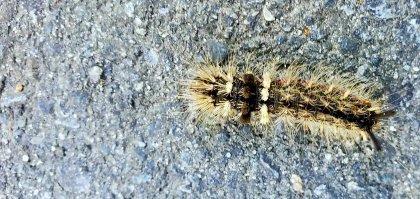
*
A couple more moth larva seen locally this summer:

rosy maple moth (Dryocampa rubicunda) caterpillar, 22 Aug. 2019, on a local trail

a polyphemus moth (Antheraea polyphemus) caterpillar ready to pupate (this is why it’s orange and not green), 26 Aug 2019, on a local sidewalk and heading toward the road (I moved it)
*
The clymene moth (Haploa clymene), a kind of tiger moth, is a very distinguishable species that I seem to see about once a summer on the lawn. This photo was taken on 30 July 2019. I’ve never noticed it in its larval form, which somewhat resembles a webworm.

*
This ipsilon dart moth was a new one for me, and I might not have noticed it on the ground if it hadn’t moved a bit. I posted it two two Facebook insect ID groups and I’m amazed that with the sunlight glaring on this specimen, two people in two separate groups actually recognised it!

Agrotis ipsilon (Ipsilon dart) moth, 8 Sept 2019
*
Another new one for me is this tiny boldly marked Archips moth (Archips dissitana), seen on Clintonia borealis (blue-bead lily) alongside a local trail, 28 July 2019; sorry it’s a bit blurry:
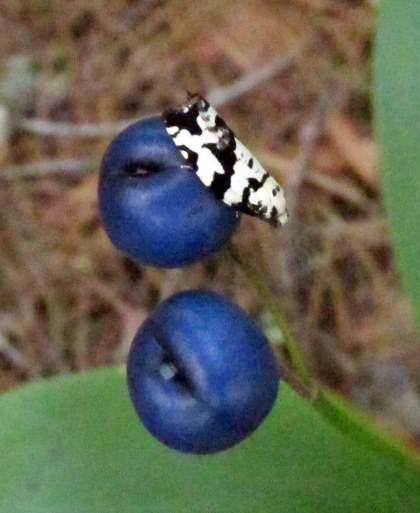
boldy marked Archips moth (Archips dissitana) on Clintonia bead, Sutton, NH, 28 July 2019
*
This giant luna moth (Actias luna) was a new and serendipitous sighting for me as well!

luna moth (Actias luna) on a local bakery storefront, 30 June 2019
*
Two moths that look more like tiny hummingbirds are the clearwing moths: the hummingbird clearwing (Hemaris thysbe) that’s olive and reddish-brown, and the snowberry clearwing (Hemaris diffinis), which is black and yellow. We’ve had many of both here all summer.
This is the hummingbird clearwing (Hemaris thysbe), on bee balm (monarda) and buddleia ‘Ellen’s Blue’:
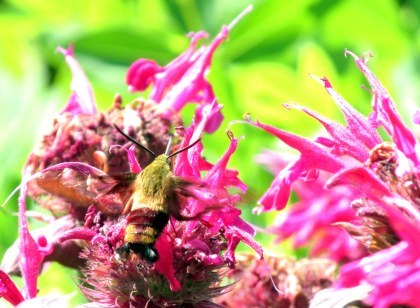

And this is the snowberry clearwing (Hemaris diffinis), on buddleia ‘Ellen’s Blue’:


I love the curled proboscis in the second photo.
*
BACK TO BUTTERFLIES
Besides the monarch and yellow swallowtails, above, another butterfly showing up here in droves this season is the painted lady (Vanessa cardui). I can’t decide if it’s more beautiful from the side or with wings open. (Shown here, on 10&11 Sept.) on buddleia, sedum, and Joe Pye weed.) There are still a lot of them around even now.
I guess I like the side the best!
Oddly, a naturalist writer near Keene, NH, about 50 miles southwest, said last week that he hasn’t seen any painted ladies this summer!
We’ve also had a fair number of American lady butterflies (Vanessa virginiensis) this season. They have only two big circles on the side of the wing, and the markings on their hindwings are quite different, too. (Shown here, from 24 July – 24 Aug,, on clethra ‘Ruby Spice’ and echinacea)
And look, I actually managed to find the larval form of the American lady!

*
I haven’t seen many white admiral butterflies (Limenitis arthemis) in the garden this year, but was able to photograph the tattered varmint on buddleia on one of the few days when I did (11 Sept. 2019). It’s a strange species, having two very different forms that used to (understandably) be considered two separate species; one is a red-spotted purple form, and the other is the “white” version, which is really black, white, blue, and reddish.

Last year I spotted one on a rotting peach (4 Sept 2018).
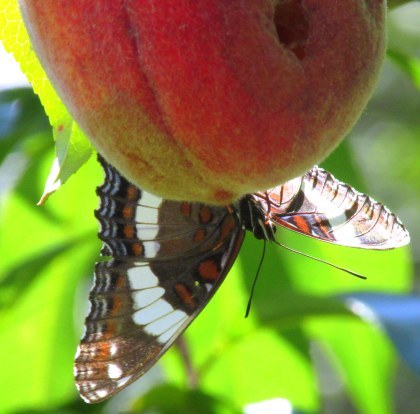
And here’s the red-spotted purple version on buddleia in the garden, seven years ago, on 1 Aug. 2012
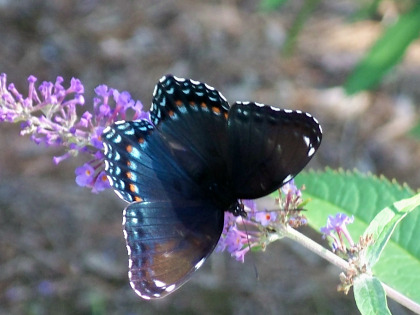
*
Early in the season we had some small fritillaries, which are so common in the south (Jekyll island, GA, for instance – especially gulf fritillaries) but not as much up here. This one was seen on 24 July 2019. I think it’s a great spangled fritillary (Speyeria cybele). We also have an aphrodite fritillary (Speyeria aphrodite) here, somewhat smaller but otherwise I can’t tell them apart.

*
These are all skippers, a small butterfly; I don’t know their species (there are almost 40 species of skippers in New Hampshire). There were a bunch around the yard in July.

27 July 2019

11 Aug. 2019 on echinacea … maybe Peck’s skipper (Polites peckius)
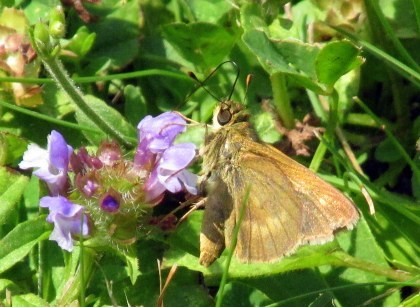
27 July 2019 on self-heal in the lawn
*
I saw a few duskywing butterflies (genus Erynnis, a kind of skipper) in July and August, including this one (I think):

duskywing butterfly (Erynnis spp) on echinacea, 3 Aug. 2019
There are 12 or so species of duskywing, sootywing, and cloudywing butterflies in New Hampshire and they all look kind of alike.
*
Here are a few more butterflies I’ve seen this year in places that aren’t my garden.
This one wasn’t even in New Hampshire, but I rarely see an Eastern comma (Polygona comma) butterfly:

Eastern comma butterfly (Polygonia comma), Laudholm Farms in Wells, Maine, 9 Sept. 2019
A couple of sightings of the common buckeye butterfly (Junonia coenia).
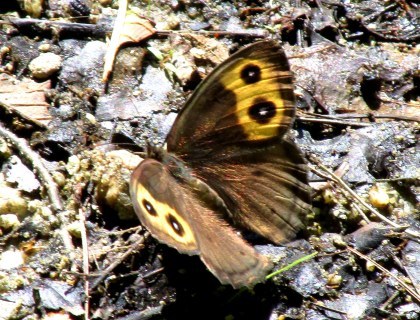
New London, NH, 26 Aug. 2019
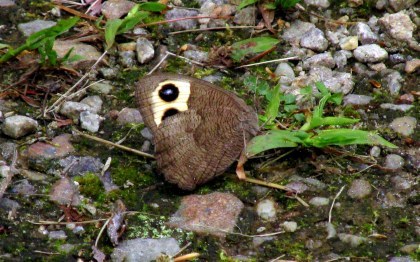
Great Bay NWR, Newington, NH, 23 Aug. 2019
*
A northern spring azure (Celastrina lucia) — I see many azures (both spring and summer species) but they are very small and very fast, hard to capture on film.
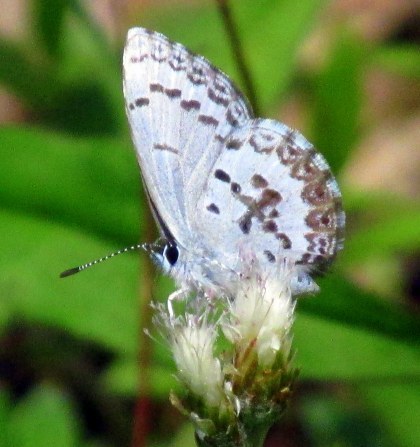
northern spring azure butterfly (Celastrina lucia), 25 May 2019
*
A crescent butterfly, probably a northern crescent (Phyciodes cocyta), but possibly a pearl crescent (Phyciodes tharos).

crescent butterfly, Enfield, NH, 19 June 2019. There are three kinds in NH — tawny, northern, and pearl; I think this is the northern crescent (Phyciodes cocyta).
*
A clouded sulphur (Colias philodice) butterfly, at The Fells Estate in Newbury, NH, 22 Sept. 2019, on pink asters:

*
This eyed brown (Satyrodes eurydice) butterfly was a new one for me. The common names — eyed brown and marsh eyed brown — just sounds incomplete to me. There’s also a Satyrodes appalachia, Appalachian brown or woods eyed brown, which is very similar (they were previously thought to be the same species), and it’s possible that’s what this is, but people who know more than I do about these things identified it as S. eurydice.
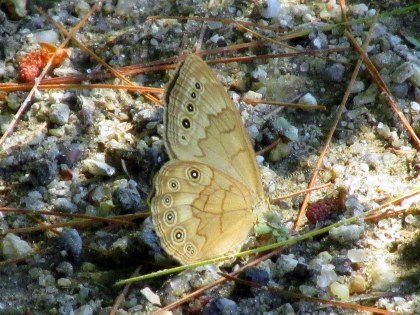
Satyrodes eurydice (Eyed Brown/Marsh Eyed Brown butterfly), Sutton, NH, 5 July 2019
*
Finally, these butterflies are fairly common here but I haven’t taken any photos of them (or even noticed a copper) yet this year, so I’m including garden photos from previous years.

cabbage white (Pieris rapae) butterfly on ‘Bluebird’ Aster laevis, 27 Sept. 2018.
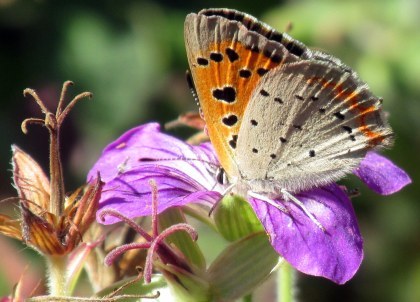
American copper (Lycaena phlaeas) butterfly on geranium, 18 Sept. 2015
I’ve never seen a mourning cloak (Nymphalis antiopa) in my garden but I see them along some trails in early spring; their our earliest butterflies. I actually saw one this spring but couldn’t get a good shot of it, so here’s a mourning cloak along a trail in Concord, NH, 23 April 2016.
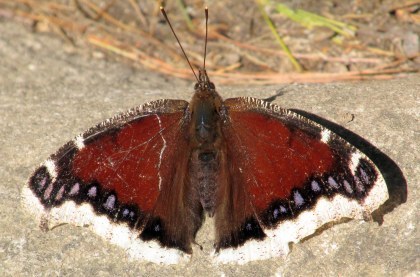
*
Sources:
The Animal Kingdom, by Joe Lewis, Yale-New Haven Teachers Institute
Ask a Biologist: True Bugs, by Adam Dolezal and Page Baluch
Phylogenic List of Insect Orders
Hummingird Moth (Mass Audubon)
Side-by-Side American Lady and Painted Lady butterflies (Mass. Butterfly Club)
Wildlife Journal Junior – NH PBS – list of insects (mostly butterflies) in NH
Featured image: monarch butterfly drying wings after eclosing, 11 Sept. 2019.
Garden Insects: Butterflies, Moths, and Caterpillars (Lepidoptera) Last year, I wrote a post on some wasps and bees I've found in my garden over the nine years I'd lived here.
#American lady#butterflies#caterpillars#clearwing moths#dagger moth#fritillary#insects#larva#lepidoptera#monarch#moths#painted lady#skipper#swallowtail#taxonomy#tiger moth#tussock moths
0 notes
Photo

According to this #woolybear #caterpillar 🐛, we are in for a harsh winter here! If he had a wide red or brown band in the middle, it would mean a mild winter. #Hipstafiend #Hipstamatic #Stavros #Blanko일 #Apollo #MakeBeautiful
1 note
·
View note
Text
catch me crying about banded woolybear caterpillars in this chilis tonight
0 notes
Link
2016-2017 Sailorway Middle School Band in the Woolybear Parade
0 notes